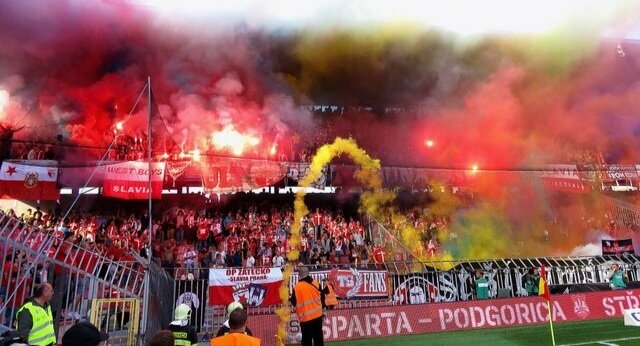The Prague Derby | A Tale of Two Identities
Derby Day in Prague in 2016 | Photo Credit
There is something especially poignant about an inter-city rivalry. The idea that thousands of rival fans can successfully coexist in the same city, save for the unmistakable tension in the air that accompanies the meeting of the city’s two (or more) opposing clubs.
The intensity of these derbies tends to be dictated by the weight of the history that surrounds the fixture, as the distinct cultural divides between the clubs, often in conjunction with a history of violence between the opposing sets of supporters produces a strained atmosphere that permeates throughout the city.
In the case of the Prague derby, the deep cultural divide between the city’s two most famous clubs, Slavia Prague & Sparta Prague, stems from both geographical & socio-economic factors.
Soical Divide in Prague
Slavia Prague originates from the Vinohrady area, in the south-east of the city, an area synonymous with Prague’s middle class. Sparta, on the other hand, grew out of the Letná region of the city, on the opposing side of the Vtlava river that runs through the Czech capital. The Letná region, at the time of the founding of Sparta, was traditionally associated with Prague’s working class, creating a clear socio-economic contrast between the two clubs.
In spite of Sparta Prague being borne out of more humble beginnings, they have largely enjoyed the upper hand when it comes to the rivalry on the pitch, having won 133 of 296 of the encounters between the two sides, as opposed to Slavia’s 91 wins in the same fixture. Similarly, Sparta have won the Czech league a record 36 times, with Slavia trailing behind on 19 domestic titles
Sparta can also boast to have considerably more impressive European & international pedigrees than those of their rivals, having regularly qualified for Europe’s top table - enjoying particular success in 1992, when they reached the semi-final stage. Sparta had also provided the backbone for the Czech/Czechoslovakia national teams, prior to the more recent trend of the top Czech players plying their trade overseas.
Sparta Prague defeat eventual winners, Olympique Marseille, during the group stages of the 1991-1992 season | Photo credit
It is obviously not unusual for footballing rivalries to have their roots in historical class differences. What is rare, however , is for these associations to be so pronounced that it leads to the government intervention. This was the case when the communist government of the 1950s forcibly moved Slavia from their stadium to a less desirable venue, as part of a wider plan to challenge the existence of the club. ‘Iron’ Sparta, with their close association to the working class, received far more favourable treatment from the same regime, with the same government building a new stadium for the club close to Slavia’s former home.
Sparta Prague & Right-Wing Politics
Although tensions between Slavia and Sparta have simmered down considerably when compared to the heights of the communist regime, violent clashes between the two sets of supporters remain common, both outside the stadium, as well as, infamously, within the stadium, as was the case during a meeting of the teams in 2013.
From the 1990’s onwards, sections of Sparta’s fanbase have veered off from their traditional communist roots and have instead been plagued by accusations of anti-semitism and other nationalist & far-right ideologies. In recent years, the Prague derby has been increasingly afflicted by controversial chants, with more none controversial than “Jude Slavia”, an overtly anti-semitic Sparta chant aimed at critiquing Slavia Prague’s alleged Jewish links. Sparta are no strangers to controversy, having already been fined previously by UEFA for racist chanting during European encounters.
Sparta Prague Ultras | Photo Credit
Banners with blatantly anti-Islamic & anti-immigrant sentiment have also been displayed at Sparta’s Letná Stadium over the last number of years, with one tifo reading ‘Je suis Chemnitz’, in reference to anti-immigrant demonstrations in the German city, as well as, as even more crude, ‘Stop Islam’, banner during the height of the European migrant crisis in 2015.
The shift of certain factions within Sparta towards the right has been alarming for many of the club’s supporters & ownership, concerned that the identity of the club might have been permanently altered.
Slavia Prague & the CEFC Group
Slavia have endured a similarly stark change in identity and structure in recent times. Having been perennially starved of resources and funds compared to their great rivals (somewhat ironically considering their former reputation as the club of the Prague’s aristocratic class). Slavia took a punt on new ownership in the form of the obscure CEFC Europe group, a conglomerate linked to the communist Chinese government; meaning that Slavia have finally got the support of a Communist government, just not the one that they might have anticipated.
The CEFC group became stewards of Slavia Prague under truly extraordinary circumstances, when Jaroslav Tvrdik, a previous Czech defence minister, managed to hastily convince a Chinese dignitary representing the group to the club, just days before representatives from the club were due to attend a bankruptcy hearing.
Supporters of Slavia were understandably taken aback by the whirlwind acquisition of the club, alongside the mysterious nature of the club’s new ownership. However, CEFC did manage to somewhat calm these concerns by delivering a first league title for the club in 10 years, in 2017, followed by a further title in 2019, allowing Slavia to once again reign supreme over its embittered rivals.
As we move towards the 300th staging of the Prague derby, a great deal has changed with regard to the identities of both clubs and both sets of supporters from when the match first took place in March 1896.
One thing that will never change, however, is the intensity of the rivalry between the two, & we eagerly await the return of football fans to stadiums so that we can once again appreciate the unique tension, history & colour that makes the Prague derby so memorable.



